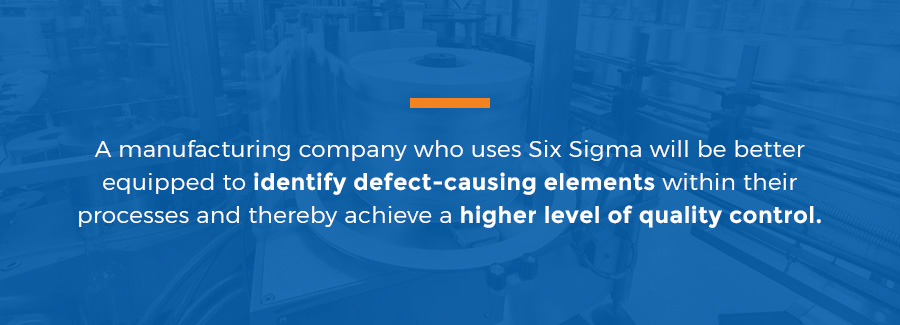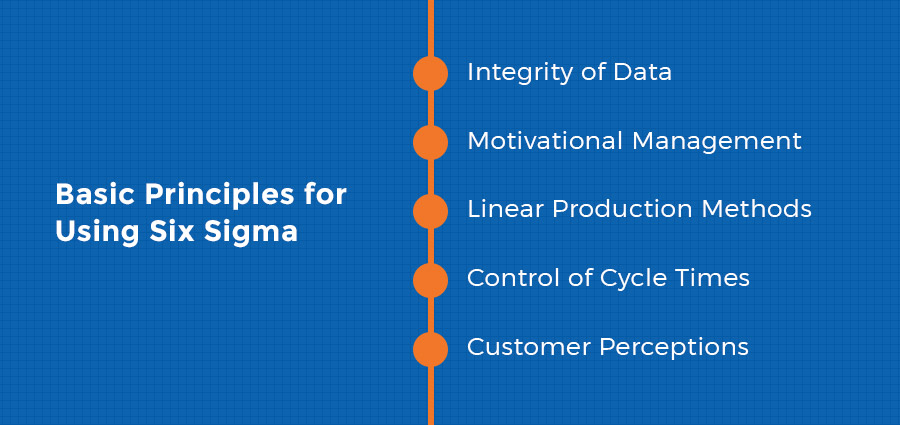Six Sigma has become a hot topic in the world of quality assurance in business and manufacturing. Since the 1980s, companies across a variety of industries have embraced the Six Sigma process and methodology, seeking to increase output, improve customer experience, lower costs and grow leaders within their organization.
What is it about this long-term quality program that has caught the attention of Fortune 500 companies all across the world, and has it truly proven to be as successful as they claim? To answer these questions and more — and see if Six Sigma may be a good fit for your business strategy — we dive into the basics, the history and the principles of Six Sigma.

What Is Six Sigma?
While Six Sigma is most widely known as a production and quality improvement method that has gained substantial traction in the last 35 years, there are actually three ways of defining the term:
- As a Philosophy: A philosophical understanding of Six Sigma dictates that defects and variation are the most costly enemies of quality and customer satisfaction. By eliminating the errors and striving for near perfection, manufacturers can improve customer experience and secure higher profits in the long run.
- As a Process: As a project-by-project approach to long-term company improvement, Six Sigma can be implemented for businesses to improve their outcomes. Using data, they can find defects, figure out their causes and rework processes for better output and quality control. This process involves investment, training, certification and application.
- As a Measurement: Six Sigma can be used as a statistical tool that focuses on maintaining 3.4 defects per million opportunities (DPMO). That means producing 99.99966 percent of deliverables at acceptable standards. It’s a term relating to standard deviation in product variation dating back to the 1920s.
All three meanings come into play when implementing the Six Sigma methodology and using its tools. Ultimately, the goal of Six Sigma is to improve processes, minimize errors, speed up response times and reduce costs to make customers happy and increase overall profits down the line.
What Is the History of Six Sigma?
In 1986, Motorola engineer Bill Smith introduced the quality goals associated with Six Sigma. After seeing initial success with Six Sigma methods, the company received the Malcolm Baldrige National Quality Award, which grabbed the attention of other leaders. General Electric’s Jack Welch made Six Sigma central to his business strategy starting in 1995, and, when he went public about the savings the methods afforded him, the Six Sigma process quickly gained traction among large companies. Since the 2000s, Lean Manufacturing has introduced elements of waste reduction and improved efficiency.

While many organizations have adopted the methods and introduced training programs for their employees to master relevant skills, at this time, there isn’t a central governing body that publishes Six Sigma knowledge and certification material. The International Organization for Standardization (ISO) released a Six Sigma program in 2011, but many institutions of higher education and consulting firms offer instructional trainings that all differ slightly in coverage and focuses.
Where Did the Name “Six Sigma” Originate?
When Motorola first began pursuing the Malcolm Baldrige Award in the 1980s, they coined the name Six Sigma for their quality improvement methods. Sigma, the lowercase Greek letter “s,” was already a term used by statisticians to refer to standard deviation, analyzing the variation within a process metric. Motorola trademarked the name with capital letters in 1993.
The “Six” in Six Sigma refers to its Sigma level or how closely deliverables reflect perfection. To reach level six, a company has to deliver no more than 3.4 DPMO, also known as a 99.99966 percent success rate. Organizations need to decrease process variation so that they can minimize the deviation between average outcomes of the process and the desired specification limits. Ultimately, this will also result in higher customer satisfaction and lowers costs.
What Is Lean Six Sigma?
Lean Management is another genre of manufacturing principles that emphasizes reducing waste and cycle times. The driving force behind Lean Manufacturing is that a misuse of both funds and time can create outcomes that are just as damaging as poor quality in production.

When paired with the Six Sigma methodologies, the two processes work in tandem to decrease variation and prevent defects from happening in the first place. They create a framework for increasing efficiency and fine-tuning operations as problems arise. On its own, Lean Manufacturing offers practical solutions to streamline business processes, but it can be exponentially more influential when working alongside Six Sigma principles.
What Are the Basic Principles of Six Sigma?
An essential element of the Six Sigma process is grasping the principles and ideas that guide it. The methodology begins with measurable goals based on data-centered observations and statistical outcomes, rather than mere hypotheses on what could happen.
Additionally, it will be difficult to master Six Sigma without viewing defects as the primary obstacle to meeting customer expectations. The focus is always to produce items that meet specifications as closely as possible, and at Six Sigma level, it will be rare that output falls short.
Here are a few other guiding principles that are crucial elements of the Six Sigma methodology:
- Constant Progress: To succeed in business, project leaders should strive for stable and consistent process results continually. Substantial progress is unlikely to happen without continued efforts.
- Process Measurability: Across all business and manufacturing industries, operational processes are made up of characteristics that can be defined and measured, meaning that they can then be analyzed and improved.
- Willing Collaboration: Reaching across department boundaries is the only effective way to work together for a unified goal. If a sustainable improvement to product quality is to be achieved, commitment will be required from the entire organization, including management. Building multi-discipline teams may be helpful to this end.

- Predictability: If you can control the input and the process, then you can control the outcome. In the end, you can predict results based on retrieved data, improving processes accordingly.
- Self-Evaluation: Another important aspect of progress is stopping to reflect on personal success or failure to see how to move forward. Determine what is working and what is not so that you can make beneficial decisions.
- Narrow Focus: Six Sigma helps companies save money and reduce defects under the primary focus of eliminating variation.
- Customer Emphasis: Measuring the impact on customer satisfaction will show the success of implemented improvements.
- Intentional Management: Rather than taking a reactive or passive approach to leadership, Six Sigma is about proactive planning, monitoring and managing.
- Drive for Perfection: To achieve Six Sigma status, the organization has to aim for perfect performance.
- Tolerance for Mistakes: You can’t be perfect without risking failure. Periodic reviews measure success, and accepting that you will fail sometimes is part of the improvement process.
Without understanding and accepting these principles, implementing Six Sigma in your organization may result in some challenges. However, if these are concepts that your staff can get behind, your next step is to look at Six Sigma’s five phases of process improvement.
What Are the Five Phases of Six Sigma?
There are two schools of thought for improving processes under Six Sigma. One, called DMAIC, focuses on enhancing existing processes, and the other, DMADV helps establish new products that will meet Six Sigma requirements.

As initialisms, these terms get their names from the first letters of the different process steps. Let’s take a closer look at what these steps entail.
1. DMAIC
Implemented for projects that aim to improve an existing business process, DMAIC involves the following five phases:
- Define what the goals of the project are, including consumer needs and what the process requires.
- Measure key characteristics of the process as is. Start understanding your process and gather the data you need.
- Analyze the data you’ve collected. Investigate cause-and-effect relationships between input and outcomes. Find the root influencers of 80 percent of the defects.
- Improve the process. Target and eliminate those problematic areas, then verify that your improvements are satisfactory.
- Control the process moving forward. Be careful not to let the same mistakes happen again.
With this workflow, you should be able to move from process to process, eliminating defects and improving your business. Now we’ll take a look at what to do when you need to create a brand-new process altogether.
2. DMADV and DFSS
To create business processes that fit within the Six Sigma framework, organizations should pay attention to the five phases of DMADV methodology as follows:
- Define your audience and the goals of your company and process.
- Measure the characteristics that are critical to quality, or CTQs. Also determine the capabilities of your product, the strength of your production process and the risks you may be taking.
- Analyze the measurements you’ve gathered to design process alternatives.
- Design the most improved alternative, based on the data you’ve analyzed.
- Verify your process design through a test run. Then, you can implement production and give the authority over to the process owner.
DFSS, which stands for Design for Six Sigma, is a third methodology that emerged with Lean Six Sigma. It is sometimes lumped in with DMADV because it also seeks to establish what the customer wants from the start, anticipating and eliminating potential defects when the process is still in its initial design phase.
How Does Six Sigma Improve Manufacturing?
When Six Sigma was first developed, it had the manufacturing industry in mind primarily. For large-scale companies, it can be difficult to determine effective strategies for improving overall performance, so the Six Sigma system was created to reduce complications and increase output quality.

A manufacturing company who uses Six Sigma will be better equipped to identify defect-causing elements within their processes and thereby achieve a higher level of quality control. Additionally, Six Sigma can help organizations reduce waste and pollution, decrease cycle times for processes and eliminate unnecessary costs. An increase in profits and customer satisfaction levels is simply the cherry on top.
A Lesson from Motorola
In 2006, Motorola revealed that they had saved more than $17 billion thanks to Six Sigma. While this significant accomplishment is worth ample recognition, the strategy that drove the way these savings were attained may come as a surprise to some.

Conventional thinking might dictate that the cost of production will go up as manufacturers increase the quality of their product. This was definitely the prevailing belief in the 1980s when the Six Sigma methodology was first introduced. However, Motorola broke the mold by recognizing that the opposite was true. Emphasizing quality in production ultimately reduces costs, and this can lead to astronomical savings, as Motorola has exemplified.
Basic Principles for Using Six Sigma in Manufacturing
Achieving a higher product quality and improving processes for the sake of measurable financial returns don’t usually happen automatically. Instead, they require excellent leadership in the areas of intentional result measuring, proactive planning and strategic execution.

To help simplify the process, here are a few common principles for manufacturing teams to acknowledge when it comes to implementing a Lean Six Sigma strategy. This list is not necessarily exhaustive or applicable to every company infrastructure.
- Integrity of Data: An effective system will incorporate only information that is known to be accurate, relevant and up-to-date. Otherwise, the success of any improvement strategy can be easily compromised.
- Motivational Management: Leadership should facilitate the collaboration between groups rather than pit departments against one another.
- Linear Production Methods: Different departments should be consistent in the linearity of their production schedules. It may require some work if processes are not currently set up linearly, but making those changes has proven to be a cost-efficient and quality-improving strategy to maximizing output potential.
- Control of Cycle Times: Stable manufacturing performance is based on short cycle times, and management should always have cycle time reduction at the forefront of process improvement efforts.
- Customer Perceptions: The satisfaction of those who purchase your products is the primary determiner of your company’s success rate. To improve perceptions, manufacturers should create projects that are proactive in breaking down communication barriers with customers and implementing suggestions based on feedback.
Companies depend on continual efforts to create and sustain reliable manufacturing processes. Part of what determines these processes is a clear, statistical measurement of relevant data and progress-oriented analysis. Six Sigma principles work their magic the best when these elements are paired with effective leadership, which is only attainable with the right kind of training.
What Are the Levels of the Six Sigma Training Program?

Part of what makes Six Sigma a unique innovation is the professionalizing and ranking of quality management responsibilities. Taking on a system whose terminology, namely the concept of belts, emulates a martial arts ability-based hierarchy, Six Sigma designates different levels of leadership and functions based on the training the employee has received. Here are the different positions, ranked from the highest level of command to the lowest:
- Executive Leadership: As the primary vision holders of Six Sigma implementation, Executive Leadership includes the CEO of the company and other top executive management staff. These individuals are responsible for setting up the Six Sigma gameplan and granting other members the resources and freedom to explore new methods of improvement, even going so far as to reach across departmental divisions to overcome resistance to change.
- Champion: Selected as key role holders by the upper management, Six Sigma Champions make sure all of the organization’s departments are working together on projects, taking responsibility for smooth integration of the methodology across the board and fruitful collaboration. They also become mentors to Master Black Belts throughout the Six Sigma implementation process.
- Master Black Belt: Champions hand-pick individual program advisors from the next level. These Six Sigma Master Black Belts give insights into effective practices and projects for the company to tackle. As coaches of the Six Sigma process, they devote 100 percent of their time to Six Sigma efforts, tasked with statistical responsibilities, the oversight of consistent Six Sigma implementation throughout the various departments and the mentorship of Black Belts and Green Belts.
- Black Belt: Under the leadership of Master Black Belts, Six Sigma Black Belts execute specific projects under the Six Sigma methodology. Like their immediate superiors, 100 percent of their time is spent on Six Sigma projects. While higher-ups are focused on identifying projects and next steps in the Six Sigma pipeline, Black Belts are given special leadership tasks to ensure the completion of their designated projects.
- Green Belt: Although they have other job functions to attend to, Six Sigma Green Belts operate under the guidance of Black Belts to perform duties related to Six Sigma projects. They also take on leadership roles as needed for the completion of certain tasks. Six Sigma is only part of their typical job responsibilities, so their authority in relevant decision-making is limited.
- Yellow Belt: Having received basic training, Six Sigma Yellow Belts are normally still reasonably new to the Six Sigma methodology. Their knowledge is not sufficient for a leadership role or authority on Six Sigma processes, but they are familiar enough to be effective participators. They focus on small improvement tasks within larger projects and use the tools they have learned to be a part of the Six Sigma efforts.
- White Belt: Six Sigma White Belts are brand-new to the Six Sigma process, having received a few hours of training. Their certification generally does not include any testing. They have enough background to understand the ongoing workings of the process, but they do not typically participate in Six Sigma projects until they achieve a higher level of familiarity with the methodology.
Each of these members of the Six Sigma practice requires specialized training, and their level of understanding needs to be tested and verified before they can participate in the system. Since the methodology has unique principles to follow and uses an unusual, data-driven approach to success, leaders need to be qualified and prove their mastery of correctly implementing process tasks.
It may be the company itself that offers the training needed to move up the ranks of the Six Sigma belt system, but there is a lot of variation in efforts to provide certification.
What Is the Six Sigma Certification Process?
To become Six Sigma professionals, employees need to complete a certification program. The program will depend on the skill level desired, whether Green Belt or Black Belt or otherwise, and involves having the individual’s command of the relevant methods verified.

In the same way that currently no governing body exists to control universal Six Sigma standards, there isn’t a sole central authority for Six Sigma certification courses and testing. Different institutions and companies provide variants of Six Sigma training, and some even come together as a group to create acceptable versions of the curriculum. This training varies in style, whether in a classroom, on-site or online.
As with most continuing education, students of Six Sigma material receive a certificate upon the completion of their course and, typically, a written exam.
What Can Your Company Do to Get Started?
The best way for your management team to kick off the Six Sigma process is to understand its concepts thoroughly. It will be crucial to follow these initial planning steps before taking action:
- Consider the initial financial investment.
- Determine a realistic rate of implementation.
- Figure out how Six Sigma will fit into your existing program.
- Establish how the new methods will be controlled and reviewed.
After these elements have been set up, the main priority of your management crew will be to engage in the process intentionally and act according to your business strategy. From that point on, your success with Six Sigma will require adaptability and constant analysis for improvement.
For more insights into trends in the manufacturing industry, check out our other posts on the Global Electronic Services blog.
